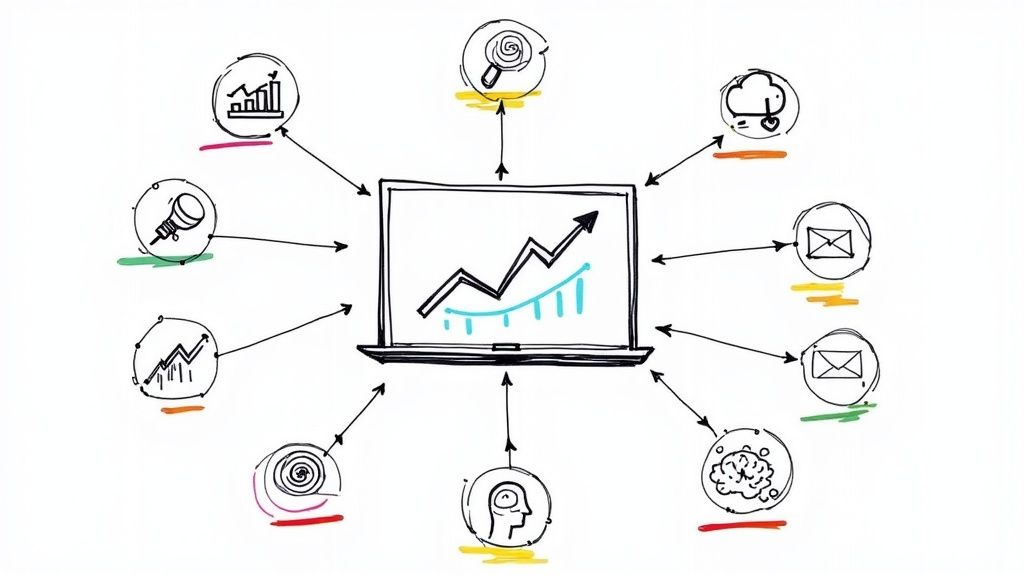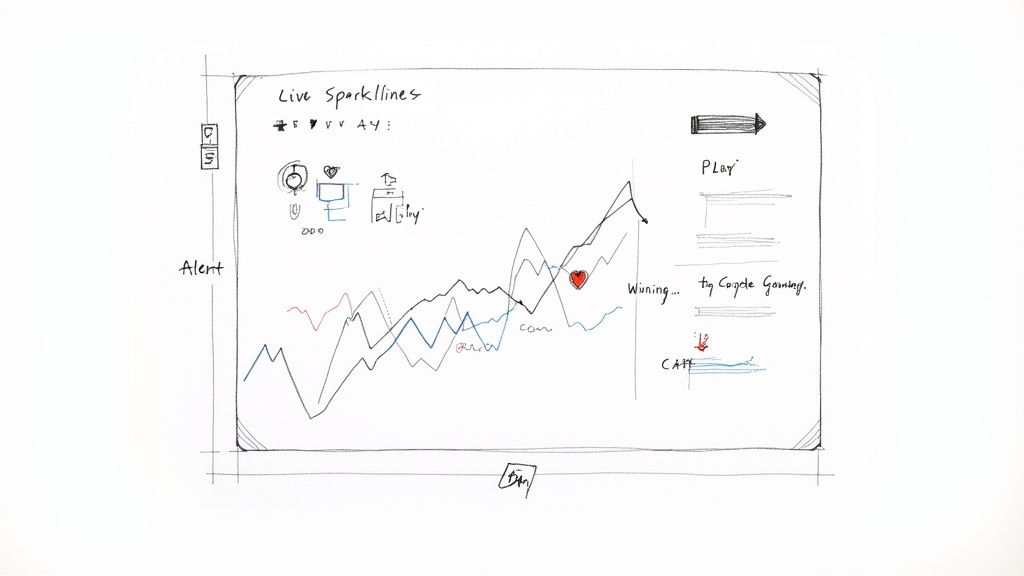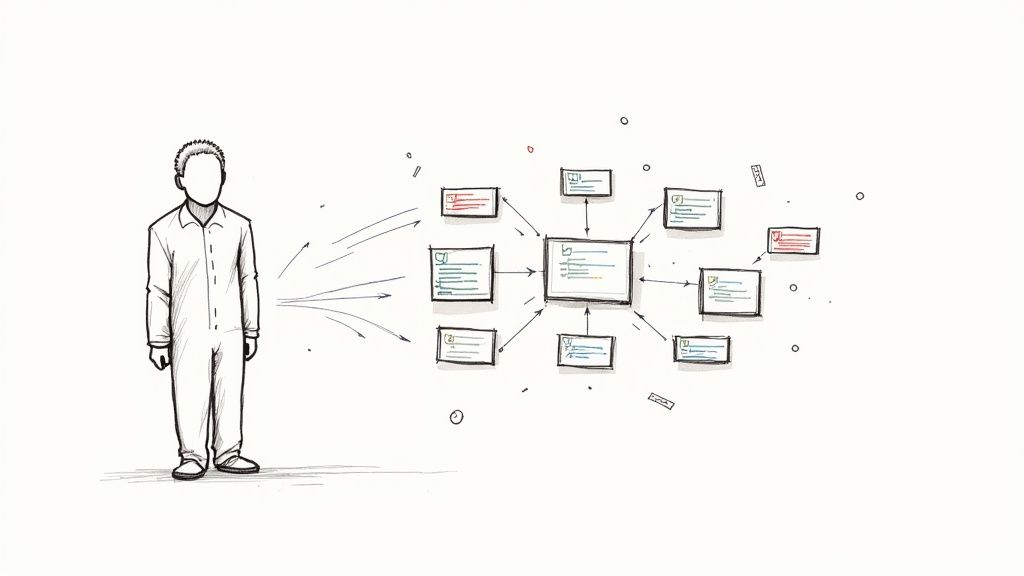
Mastering Lead Generation for Healthcare: Proven Strategies for 2025
Master lead generation for healthcare with proven strategies for 2025. Learn to attract, nurture, and convert quality leads in the complex healthcare market.

In a world saturated with digital noise, the most successful brands aren't just shouting louder; they're listening smarter. The era of 'spray and pray' marketing is over, replaced by a more precise, effective, and accountable approach. Welcome to the age of data-driven marketing, where every decision, from ad creative to budget allocation, is guided by actionable insights, not intuition.
These data driven marketing strategies are no longer a luxury for enterprise giants; they're essential for any business aiming for sustainable growth. Gut feelings can only take you so far. To compete effectively, you need to understand what is working, why it's working, and how to replicate that success consistently. This requires a fundamental shift from creative-led campaigns to data-informed initiatives that prioritize customer understanding and performance metrics.
This article will break down 10 powerful strategies that leverage data to transform your marketing efforts into a predictable growth engine. We'll move beyond the buzzwords and provide clear implementation steps, real-world examples, and the specific tools you need to get started. You will learn how to build predictive models, optimize your marketing mix, and create deeply personalized experiences that drive genuine customer loyalty and revenue.
Predictive analytics is a powerful data-driven marketing strategy that shifts your efforts from reactive to proactive. Instead of just analyzing past performance, this method uses historical data, statistical algorithms, and machine learning to forecast future outcomes. It helps you anticipate customer needs, identify potential churn risks, and optimize campaigns before they even launch.

This approach analyzes patterns in past transactional data, website interactions, and demographic details to create models of what customers are likely to do next. For example, Netflix uses predictive models to suggest shows you might like. Transitioning your marketing mindset is key, and a guide to predictive and prescriptive analytics can be indispensable for forecasting future trends and modeling customer behavior accurately.
To get started, first define a clear business goal, such as reducing customer churn. Next, gather and clean relevant historical data, ensuring it is complete and accurate. You can then use tools like Salesforce Einstein or custom models to build and test your predictions.
Customer segmentation is a foundational data-driven marketing strategy that involves dividing your broad customer base into smaller groups based on shared characteristics. Micro-targeting takes this a step further, using granular data points to create highly precise audience clusters. This allows you to deliver personalized campaigns that resonate deeply with each segment's unique needs.
This approach analyzes everything from demographics and purchase history to online behavior to inform your targeting. For instance, Sephora’s Beauty Insider program segments customers by purchase frequency to offer tailored rewards. Developing detailed buyer personas is a critical step, and this guide on how to create buyer personas can help you build accurate profiles for each segment.
To begin, identify key data points that can differentiate your customers, such as their purchase habits or demographic details. Use marketing automation tools like HubSpot or Mailchimp to create segments based on this data and start crafting targeted messages for each group.
Attribution modeling is a crucial data-driven marketing strategy that identifies which touchpoints deserve credit for a conversion. Instead of relying on simplistic last-click models, modern attribution analyzes the entire customer journey, showing how different channels like social media, search ads, and email work together. This clarity is essential for effective marketing mix optimization.
This approach uses data to quantify the impact of each marketing investment, helping you allocate your budget more effectively. For example, e-commerce platforms use attribution to determine the perfect channel mix for maximizing sales. Understanding the contribution of each channel is fundamental to measuring marketing ROI and ensuring your budget is invested, not just spent.
Start by ensuring your tracking is correctly set up across all marketing channels, using tools like Google Analytics 4. Once data is flowing, you can choose an attribution model that fits your business needs, such as a time-decay or data-driven model, to analyze campaign performance.
Real-time analytics transforms marketing from a "set-it-and-forget-it" function into a dynamic, continuously optimized operation. This data-driven marketing strategy provides immediate visibility into campaign performance, enabling you to make rapid adjustments. This agility allows teams to pause ineffective ad spend and scale winning tactics as they happen.

This approach leverages live dashboards and automated alerts to shorten decision-making cycles. For example, an e-commerce site can automatically scale ad budgets toward high-converting products mid-campaign. Platforms like Google Data Studio and Tableau are essential for building the feedback loops needed to respond to market conditions instantly.
To start, integrate your marketing platforms with a real-time analytics tool to create a centralized dashboard. Define key performance indicators (KPIs) and set up automated alerts for significant changes, such as a sudden drop in click-through rates.
This strategy involves visualizing the complete path a customer takes from initial awareness to post-purchase engagement. By collecting and analyzing data from every touchpoint, such as your website, email campaigns, and social media, you can create a holistic view of the customer experience. This allows you to identify friction points and opportunities for improvement.
Customer journey mapping is one of the most effective data driven marketing strategies for understanding how different channels work together. For instance, a retail brand can connect a customer's online research to a final in-store purchase. This unified view helps pinpoint where to invest resources for the greatest impact.
To begin, focus on mapping the journey for your most valuable customer segments. Gather data from various analytics platforms like your CRM, email software, and web analytics to build a timeline of interactions. Tools like Segment or Mautic can help consolidate this multi-channel data.
Personalization engines are a cornerstone of modern data driven marketing strategies, using data to deliver customized content in real-time. These systems analyze user behavior and preferences to automatically determine what products or messages will resonate most with each individual. This creates a more relevant and engaging customer journey.

This technology powers many common experiences. Amazon’s product recommendations, Netflix’s personalized homepages, and Spotify's Discover Weekly playlists are all driven by powerful personalization engines. These systems learn from every user interaction to continuously refine their output. To go deeper, exploring how to use AI in marketing can provide valuable insights into leveraging these advanced tools.
To begin, start by defining which part of the customer experience you want to enhance, such as the homepage. Gather user data from various touchpoints and select a personalization tool like Optimizely or Dynamic Yield that aligns with your goals.
Marketing automation with lead scoring is one of the most effective data driven marketing strategies for efficiently nurturing prospects. This approach uses automated workflows to deliver personalized content while scoring leads based on their demographic information and online behavior. This ensures your sales team focuses its energy on the most promising, sales-ready leads.
This strategy analyzes actions like email opens and page visits to assign a numerical value to each lead. For example, a B2B SaaS company might assign a high score to a user who visits the pricing page, signaling strong purchase intent. Platforms like HubSpot and Marketo excel at creating these automated nurturing sequences that move leads seamlessly through the funnel.
To begin, collaborate with your sales team to define what constitutes a "qualified lead." This is critical for setting meaningful score thresholds for sales handoffs. From there, you can build a scoring model that incorporates both positive actions (e.g., requesting a demo) and negative ones (e.g., unsubscribing).
Cohort analysis is one of the most insightful data-driven marketing strategies for understanding long-term user behavior. Instead of looking at your entire user base as one group, this method segments users into cohorts based on shared characteristics, typically their acquisition date. By tracking these groups over time, you can measure retention and lifetime value with greater accuracy.
This approach helps you understand how changes to your product or marketing impact user loyalty. For example, a SaaS company can track cohorts to see if a new feature improved retention. For a deeper dive, exploring e-commerce growth data analysis tools for LTV, CAC, and cohorts is essential for mastering customer value and retention.
Start by defining your cohorts, most commonly by user sign-up month or acquisition channel. Then, choose key metrics to track, like monthly retention rate. Use analytics platforms like Google Analytics, Amplitude, or Mixpanel to visualize cohort data.
Competitive intelligence is a data-driven marketing strategy focused on systematically collecting and analyzing information about your rivals. By understanding their marketing activities and pricing, you can make more informed strategic decisions. This approach uses tools for social listening and ad intelligence to uncover competitor campaigns, messaging, and market trends.
This strategy helps you identify market gaps and refine your positioning. For instance, an e-commerce store might track a competitor’s pricing to adjust its own offers. Leading platforms like Semrush and Similarweb have popularized this by making sophisticated competitor data accessible.
To begin, identify your top competitors and define the specific data points you want to track, such as pricing changes or social media engagement. Use a mix of automated tools and manual analysis to gather and interpret the information, ensuring you cross-reference insights for accuracy.
An experimentation framework institutionalizes a culture of continuous learning. This data-driven marketing strategy replaces guesswork with rigorous statistical methods to test hypotheses before committing significant resources. By systematically conducting A/B tests and multivariate tests, you can determine what truly works for your audience.
This approach ensures your marketing decisions are backed by reliable data. For instance, Booking.com famously runs thousands of experiments simultaneously, optimizing every element of its user journey. Adopting a testing mindset, supported by platforms like Optimizely, accelerates learning and drives incremental improvements across all marketing activities.
To build an effective experimentation program, start by defining a clear hypothesis for a high-impact area, like your checkout page. Use dedicated testing tools to set up and run the experiment, ensuring you collect enough data for a statistically significant result.
The ten data driven marketing strategies we've explored represent a fundamental shift in how businesses connect with customers. By weaving these approaches into your operations, you transform marketing from a cost center into a predictable, measurable engine for growth.
The journey begins with a commitment to listening to what your data is telling you. It's about understanding customer behavior, identifying valuable segments, and mapping the paths they take to conversion. Whether implementing dynamic content or refining your marketing mix with attribution modeling, the core principle is the same: let evidence guide your decisions. This empowers you to create more relevant and impactful experiences.
Embracing this new paradigm can feel overwhelming, but progress is about momentum, not perfection.
Ultimately, mastering these data driven marketing strategies is about building a more efficient, resilient, and customer-centric business. By activating your data, you stop shouting into the void and start having meaningful conversations with the people who matter most. This strategic pivot ensures every dollar you invest is a calculated step toward sustainable success.
Ready to accelerate your growth with a partner dedicated to measurable outcomes? BrandBooster.ai combines expert strategy with powerful AI to implement these data driven marketing strategies for you, turning your marketing spend into a predictable engine for success. Discover how we can transform your data into your most valuable asset by visiting BrandBooster.ai today.